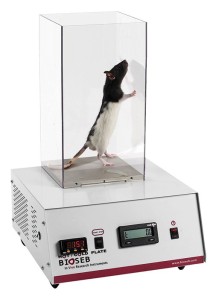Authors
A Rapacz, S Rybka, J Obniska, A Jod_owska, M Góra
Lab
Department of Pharmacodynamics, Faculty of Pharmacy, Jagiellonian University Medical College, Krakow, Poland
Journal
European Journal of Pharmacology
Abstract
The objective of this study was to evaluate analgesic and antiallodynic activity of four new 3-benzhydryl-pyrrolidine-2,5-dione derivatives, which demonstrated previously anticonvulsant activity in the seizure tests in mice. Analgesic activity was examined in acute (the hot plate test), tonic (the formalin test), as well as neuropathic (the oxaliplatin-induced peripheral neuropathy) pain models in mice. Moreover, potential sedative properties and hepatotoxicity were evaluated. To establish the plausible mechanism of action, in vitro assays were carried out. All tested compounds RS 34, RS 37, RS 48, and RS 49, similarly to pregabalin, were active in the second phase of formalin test, a model of tonic pain. The most promising effect was observed for compounds RS 34, RS 48, and RS 49, which in a statistically significant way attenuated the nocifensive response at all tested doses 1, 10, and 30 mg/kg. Furthermore, all compounds at a dose of 30 mg/kg revealed antiallodynic activity in neuropathic pain related to chemotherapy-induced peripheral neuropathy in mice. In experimental tests on three compounds RS 34, RS 37 and RS 48 at active doses no sedative properties were registered. In the in vitro assay the selected molecule RS 34 did not induce cytotoxic effect on hepatoma cells. The binding and functional studies did not provide firm evidence on possible mechanism of action of these derivatives. In conclusion, the tested pyrrolidine-2,5-dione derivatives with antiseizure activity exerted also analgesic and antiallodynic effects in mouse models of pain.
BIOSEB Instruments Used
Cold Hot Plate Test (BIO-CHP)
Source :
https://www.sciencedirect.com/science/article/abs/pii/S0014299919308428

 Pain - Thermal Allodynia / Hyperalgesia
Pain - Thermal Allodynia / Hyperalgesia Pain - Spontaneous Pain - Postural Deficit
Pain - Spontaneous Pain - Postural Deficit Pain - Mechanical Allodynia / Hyperalgesia
Pain - Mechanical Allodynia / Hyperalgesia Learning/Memory - Attention - Addiction
Learning/Memory - Attention - Addiction Physiology & Respiratory Research
Physiology & Respiratory Research











![Dynamic Weight Bearing 2.0 – Postural Module [Add-on]](https://bioseb.com/733-home_default/dynamic-weight-bearing-20-add-on-postural-module.jpg)
























 Pain
Pain Central Nervous System (CNS)
Central Nervous System (CNS) Neurodegeneration
Neurodegeneration Sensory system
Sensory system Motor control
Motor control Mood Disorders
Mood Disorders Other disorders
Other disorders Muscular system
Muscular system Joints
Joints Metabolism
Metabolism Cross-disciplinary subjects
Cross-disciplinary subjects CONFERENCES & MEETINGS
CONFERENCES & MEETINGS 